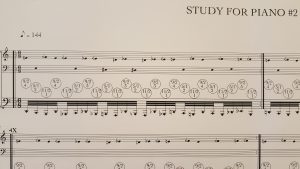Techniques and practical tips
The single most important factor influencing the sound quality of a harmonic is how close to the actual node the finger is placed, so marking the nodes carefully is an essential part of the preparation. I (Jonas Olsson) usually use a CD/DVD marker for my markings, which can easily be removed with a small amount of acetone or alcohol on a cloth. Be careful, and always leave the instrument in better condition than you found it!
For isolated harmonics I normally prefer to have my left hand on the strings and right hand on the keys (especially in ensemble pieces where there is usually a conductor on my right-hand side); however when playing only harmonics for a long time (as in Johan Svensson’s Studies) I prefer to have my right hand on the strings, move my chair to the left and use my left foot as support. Putting the score on an extra music stand on the left-hand side of the piano could also be a good idea, to avoid turning head and body in opposite directions.
Notation
Simple harmonics have been in use for a long time and rarely require much explanation. For higher harmonics, I propose the following solution: in the lower staff, diamond-shaped noteheads show which keys to play, while the resulting pitches are shown in the smaller-sized upper staff. For clarity, these may be shown without stems, and rounded off to the nearest quarter-tone. Between staves, the number and location of the harmonic node can be expressed as a fraction (for example, 9/2 means the second node of the ninth harmonic). If necessary, fingerings can be added below. See the example from Johan Svensson’s Study #2.
